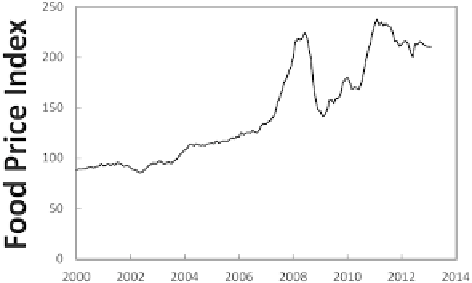Agriculture Reference
In-Depth Information
Fig. 13.2
World nominal food price index for the new millennium. The FAO Food Price Index is
a measure of the monthly change in international prices of a basket of food commodities. Data for
January 2000 to March 2013 extracted from FAO database (Anon
2013
)
in the present economic environment, whilst inflation for fruits and vegetables re-
mains stubbornly high. Demand is also relatively static, with some standard lines
for many fresh produce types falling out of favor to products of lower specification.
The problem is compounded by consumer purchasing power and confidence being
at an extended low ebb. Yet a dichotomy exists whereby quality demands for horti-
cultural products keep increasing or at least are at an unsustainable level, such that
something has to change or break in order for the industry and growers to remain
competitive and continue to invest in new postharvest technologies. The incentives
for doing so seem to be centered on gaining market share in a period of austerity
and reducing waste through implementing stricter key performance indicators with
the view that things will eventually turn and become more favorable. The scope for
introducing new postharvest technologies in a stagnant market is therefore limited.
Quality remains the mainstay of many supermarket offerings as it can markedly
influence footfall, market share and the incidence of customer defections. Qual-
ity is intimately linked with postharvest technology and biology, yet the drivers of
demand are increasing centered on price and promotions (e.g. buy one get one free
and multi-buys). Since 2008, promotions are being used more widely by retailers
in the developed world to increase the affordability of fruit and vegetables as well
as attract new customers (and stop customer defecting to other stores). In this sense
they are part of the discussion about price/value and can increase footfall.
The effectiveness of fruit and vegetable promotions on demand is difficult to
analyze. For example, promotions are usually time-limited and are traditionally
used to celebrate the season and clear 'gluts'. Where flushes or gluts are predict-
able (e.g. release from end of storage apples) then they can perform a valuable role
in promoting greater product utilization and decreased waste, but even so may not
increase demand overall. Another possible impact is that consumers' simply switch
away from a product that is not being promoted to one that is. If both are fruits,
for example, there is no overall increase in fruit purchases—a process known as
product 'cannibalization'. Promotions can have other unforeseen consequences that

